Driving through Lagos, Nigeria
I did a lot of driving on my recent visit to Lagos, Nigeria. Or rather, I did a lot of being driven.
Lagos isn’t your usual tourist destination and, indeed, I didn’t go there as a tourist. I had agreed to lead a workshop at an International Baccalaureate school for two days. If I was going to fly all the way to Nigeria, I figured, I should at least stay one extra day and see something.
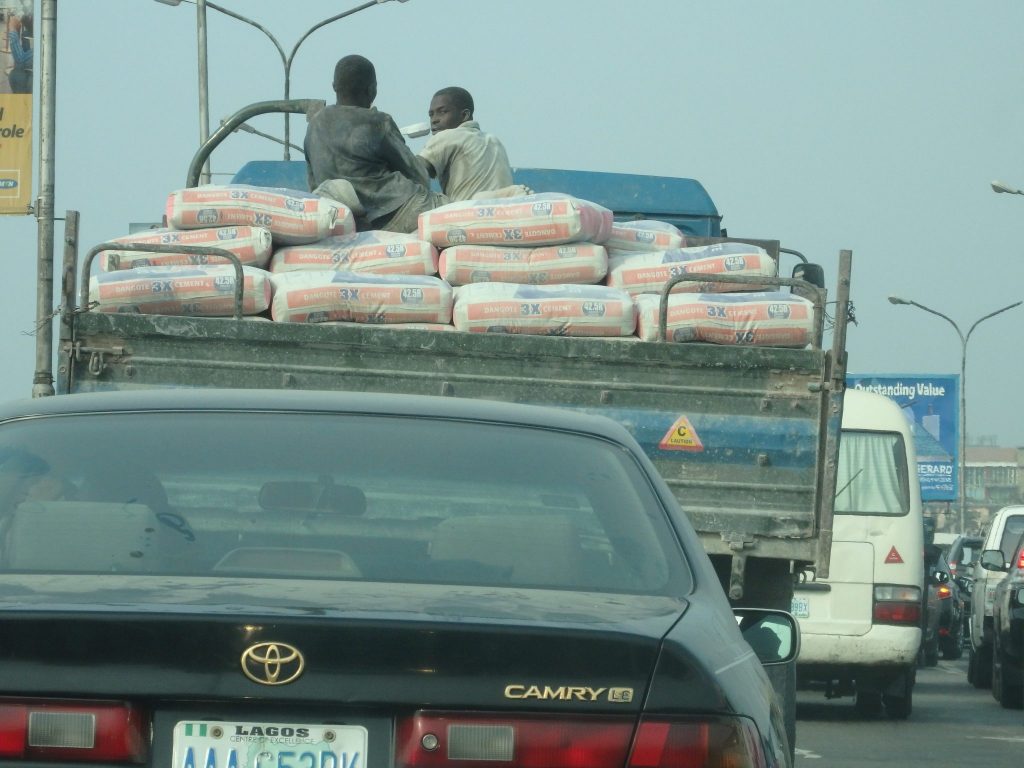
After a brief on-line search, I decided to visit Badagry, Nigeria’s equivalent of Elmina and Cape Coast in Ghana: places where slaves were collected and held, and where the Europeans arrived in their slave ships to take them away to the Americas.
While tour companies offer excursions to Badagry, I was fortunate enough to get a car, with a driver and the school’s head of security as travel companions, from the school. They picked me up at my hotel at seven in the morning, and we set off.
Badagry is listed as being about an hour away from Lagos, but it ended up more than two hours each way. There were two reasons for this. First, an hour away from where? Lagos is a huge, sprawling city of about 22 million inhabitants. According to my travel companions, Badagry isn’t even outside of Lagos; it’s within the city boundaries. And yet it took us two hours to get there. (I think they might have meant that Badagry is in the state of Lagos, rather than the city.)
I’ll tell more about Badagry itself in a separate post. For now, I’d like to tell about the driving itself.
The Roads in Lagos
The other reason for our slow progress was the state of the roads. Some sections of the highway are in good shape, with two or three well-paved lanes each way. Some sections, however, are more pothole than pavement. And when I say “pothole”, I really mean that the pavement abruptly ends, causing drivers to slow to a crawl in order not to break axles going into or out of these asphalt-less sections, which are considerably lower than the pavement itself. You can get an impression of these in this short video:
Traffic in Lagos
Traffic also slowed our progress, especially when we went to and from the airport. On that route, the road is a highway, marked with lanes, which often are completely ignored. Three lanes generally become four, and my driver seemed particularly adept at creating extra lanes. Passing on the right is perfectly acceptable, and drivers honk often, not in anger but more to let other drivers know what they are doing: “I’m coming up on your right in a lane that doesn’t even exist! Please watch out!”
Sometimes and in some places, the sheer volume of vehicles forces everyone to slow to a crawl, even where the pavement is good.
Street Scenes in Lagos
Nevertheless, driving in Lagos—on the outing to Badagry and on my trips to and from the school—is fascinating. Passing markets and residential areas and industrial areas meant I could study the city’s life to my heart’s content because we moved so slowly.
In the more central, more crowded part of the city, buildings are close together and every bit of space is used. Further out, buildings sit apart and their lots are away from the road, often delimited by a wall around the property line. In some places the land between buildings has been planted with cassava or covered with shanties made from scraps of metal and wood.
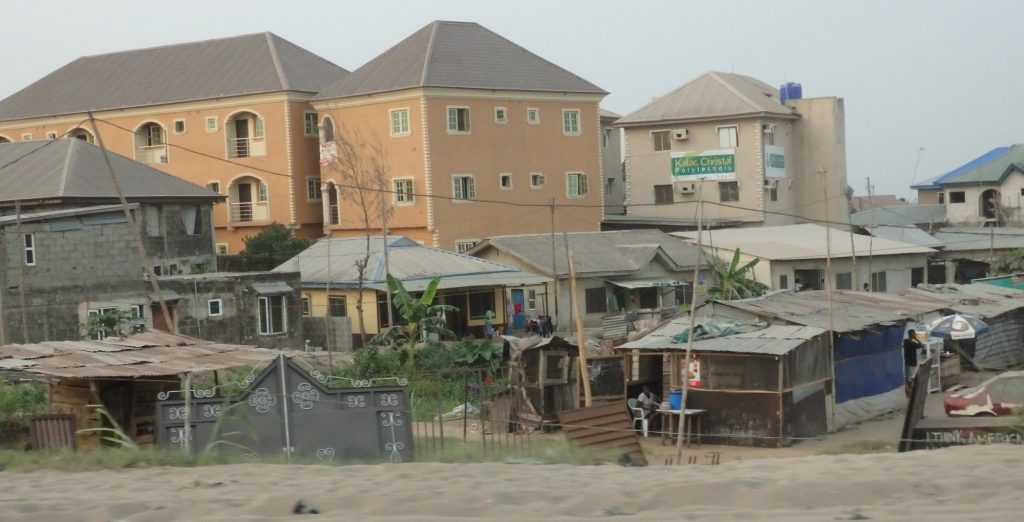
Outside the center, where there is more space, haphazard, makeshift buildings fill the space between the road and the walls along property lines: shacks, essentially, made from bits of wood or corrugated iron, though some seemed more solidly built. Most of these do not appear to be homes, like the shantytowns I glimpsed on vacant lots here and there. These are shops, with open fronts to display items for sale.
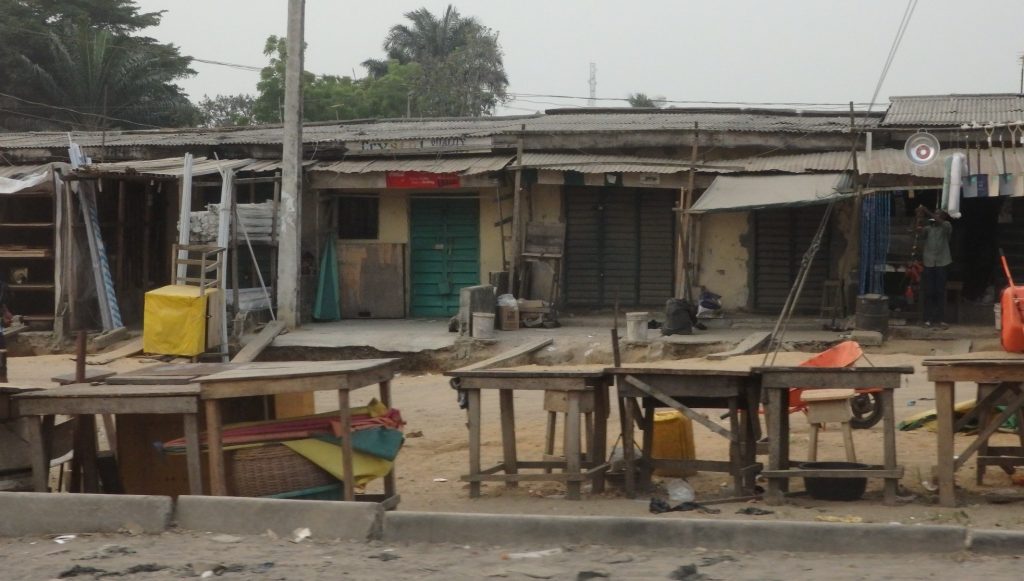
Besides the general chaos of the traffic, activity along the roads mostly involves commerce: women buying and selling in busy market stalls, young men with motorcycle taxis, waiting for clients, furniture makers displaying their products, hawkers braving the highway itself to sell small snacks through car windows, women carrying goods on their heads, shoppers heading home from work after buying their provisions for dinner.
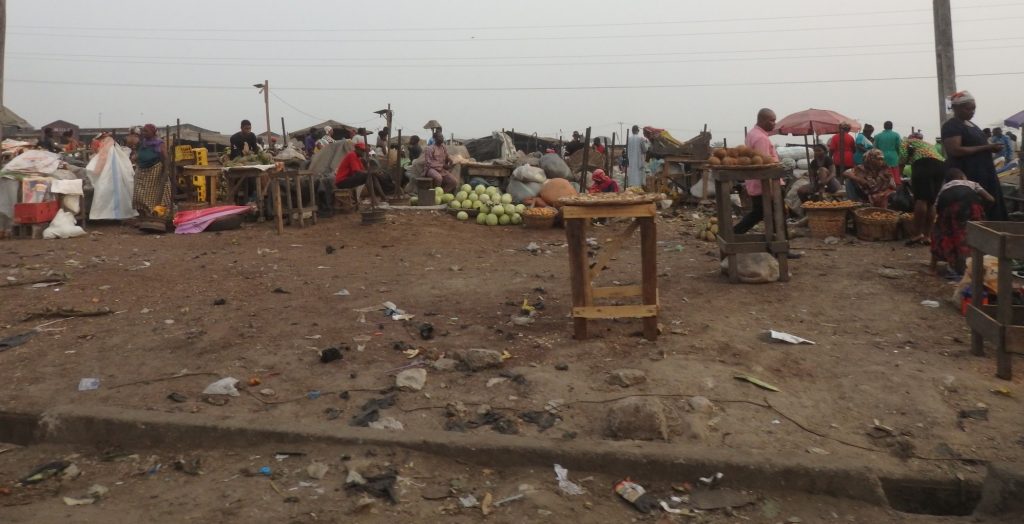
While many people wear western clothing, some women wear brightly-colored traditional Nigerian dresses. I spotted quite a few men in traditional clothing too: either matching shirts and pants in the same brightly-patterned cloths as the women, or in long, plain boubous.
a woman in Nigerian dressEverything and everyone is covered in a thick layer of dust: the sides of the road, as well as the big sections where the pavement is gone, are all sand. Presumably this will turn to mud when the rainy season starts soon. The center “divider” is a strip of sand as well, several meters wide, and in the busier business areas people use that space as well for buying and selling, or just for sitting.
Garbage is everywhere: plastic bottles and other bits of plastic, mostly. It litters the road and the paths beside the road. It accumulates in heaps in the markets. I did spot one garbage truck in three days of driving around the city, but clearly garbage collection is an issue in a city this big and this poor.
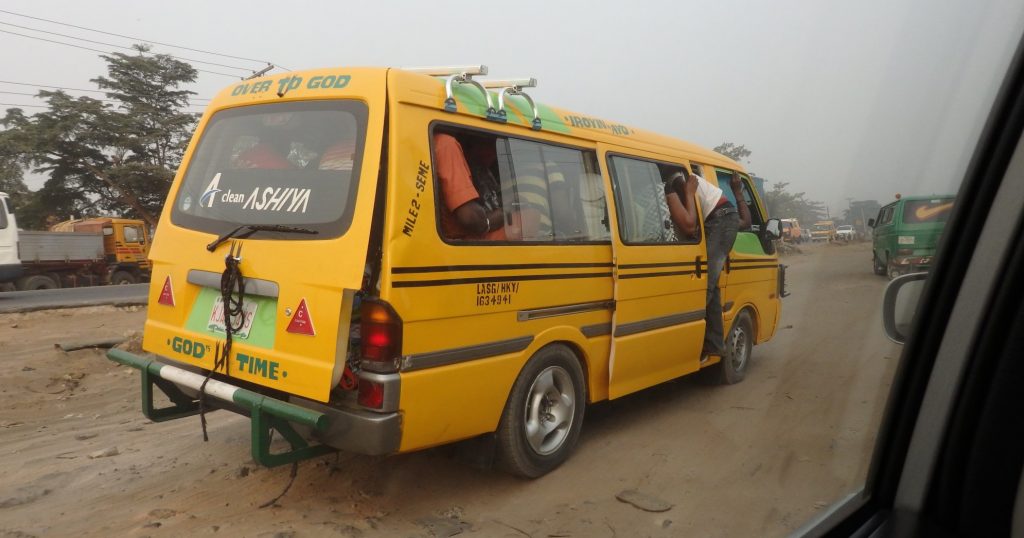
Many of the vehicles on the road are vans, used as buses, crammed with people. Some are bright yellow “tricycles,” an open-sided, three-wheeled motorized vehicle used as a taxi.

Every few kilometers, where the vans and tricycles stop, so does the traffic, because the vans take up lanes of the road, though no one seems particularly upset by it. Those spots are the busiest. Hawkers converge on the stopped cars as well as the vans. Men shout loudly and repeatedly, trying to find more customers for their vans. Customers negotiate back. Ramshackle market stalls sell fruit, small bags of water and other small, cheap products to travelers.
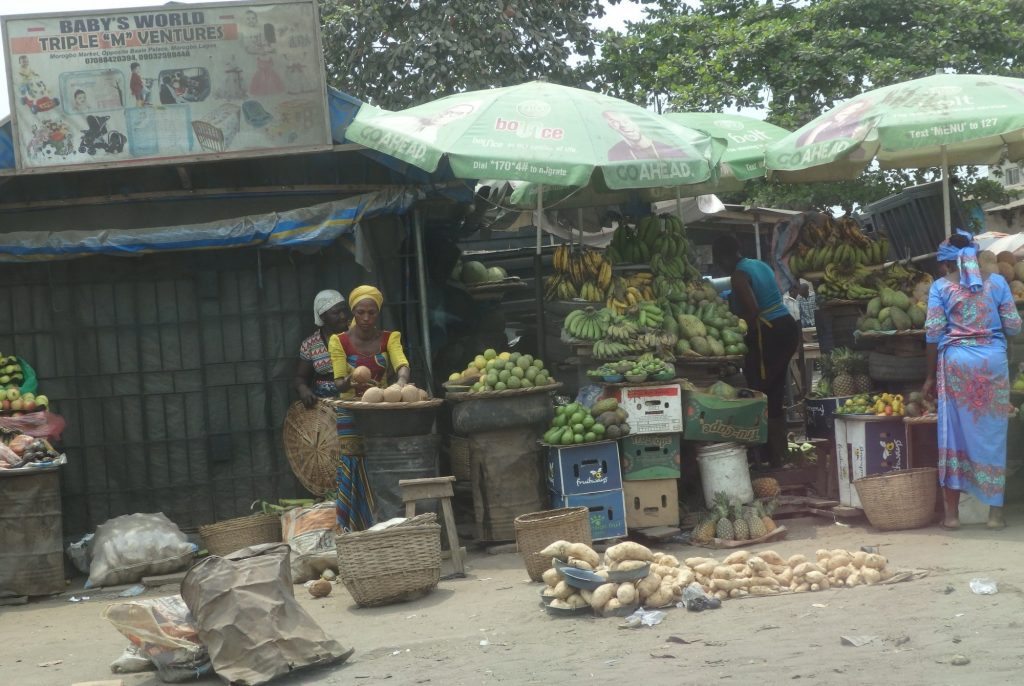
The cleanest, most modern buildings we passed are gas stations and banks. Housing, besides the clusters of piecemeal shanties on vacant bits of land, seems to mostly be in apartment blocks, some in better condition than others. Stalls have been added to many of the buildings on the ground floor, appearing as much of a mish-mash as the shacks of the markets and the shantytowns.
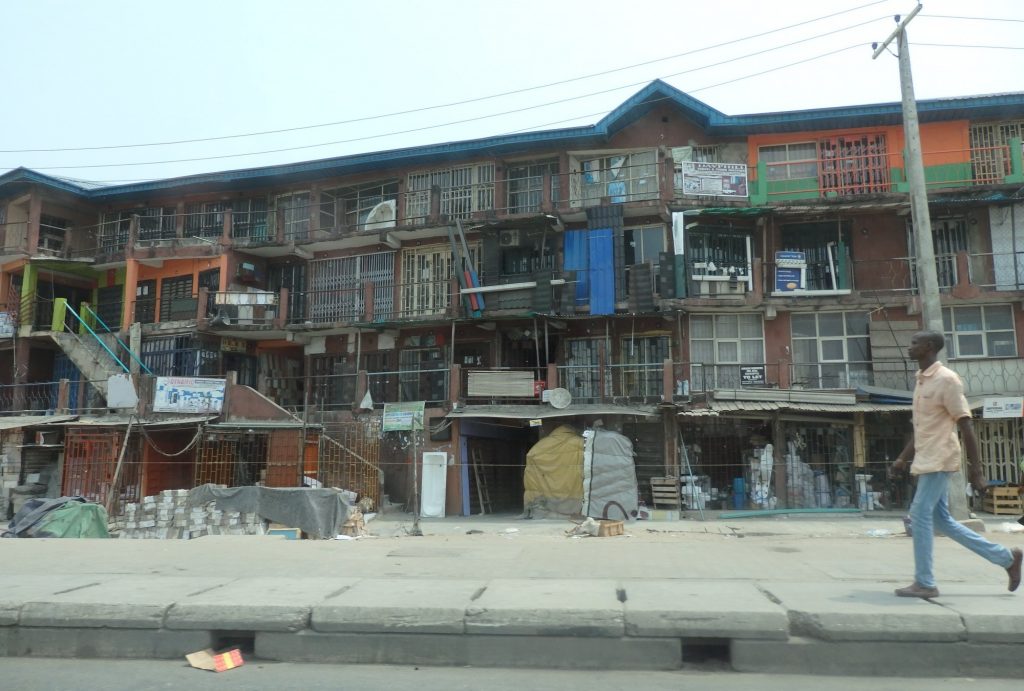
I saw many churches of various denominations, most of which I’d never heard of. Mostly they are as shabby as the market shacks, with nothing but a hand-painted sign to show it’s a church. A few times I spotted a mosque, and these seem more substantial buildings than the churches.
Badagry itself is smaller scale in general: more like the small town it once was. Low-rise buildings and shops line the streets, which are narrow, compared to the multi-lane roads we drove for the rest of my visit.
A shopkeeper and her shop in BadagryMy overall impression of Lagos was of chaos, but also of industriousness, aspiration, and true capitalist spirit.
Have you ever been to Lagos, or another city that my description reminds you of? Add a comment below!



These photos, your descriptions, and the way people live remind me so much of where I grew up (Vung Tau, Vietnam) back in the late 80’s and early 90’s. This town is now a bustling tourist destination, but when I was growing up there, houses looked just like the ones you showed here and people did everything they could to get by. But believe it or not, I loved living there – maybe because I was used to it and it didn’t bother me, but life was MUCH simpler then. Though we were poor, we had each other and time to be with family. Now we have so much but no time for each other because we’re working all the time…
I’m not surprised you loved living there. Any place with community and love (assuming you have enough to eat and a roof over your head) will be a good place to grow up. And I know what you mean about having so much but not time for each other. We get in this cycle of wanting more stuff but then having to work more to get it so we don’t have time to enjoy anything anyway.
Wow! Those roads are terrible! Not sure why there is any asphalt paving because at least the dirt road would be more even.
I presume there was pavement there once! Imagine what it becomes in the rainy season!
I love the traditional dress and the chaos. It reminds me of a combination of experiences we’ve had here in Fiji, and again in SE Asia – Quy Nhon and Luang Prabang in particular (even though the climate there is far more wet).
This was the dry season. I can only imagine how bad the roads must become in the wet season!
I liked the final photo of the woman & her son outside of her shop– she obviously understands how to organize!
I’ll bet that the undermining of the asphalt that IS there happens exactly during the rainy season- it probably floods & then the sand runs out from under it, causing the next few inches to give out & crumble.
Wow, I can’t imagine living in that chaos continuously…we are so spoiled!
Yes, that’s probably what happens if the road’s built on sand and it rains hard! That last photo was one of very few that I didn’t take through the window of a moving car, so I had time to set it up properly.
So interesting. Your comment about the dust and dirt in dry season reminded me of our time teaching in a poor neighborhood in Nicaragua – dust everywhere, coating everything. I remember showering as soon as we’d get home and thinking that poverty could be portrayed by dust, dirt and heaps of trash. On the other hand I remember lots of smiles and feeling that I’d received more than I gave…
Definitely! That’s how I felt after my two years in the Peace Corps in Malawi: like I got distinctly more out of it than Malawi did!
Very interesting. Love the woman in the Nigerian dress!
Thanks, Michelle!
Lagos has too many cars, not enough roads, so, the result is constant traffic.
Yes, it sure looked that way! It didn’t seem to matter what time of day it was.
Nigeria is another failed african country.human rights and Constitution are violated daily,under the nose of nigerian government.police abuse has reached high levels,innocent citizens beaten and arrested without reason.many nigerians died due the police conflicts with local people. Buhari administration has put nigerians in deep poverty. higher inflation,higher fuel price and food,low salaries,where minimum wage is 64 dollars per month,is making nigerians life a struggle. 14 million nigerians are illiterates,and more than 9 million kids never been to school. this is what happens when you vote for promises or next level.